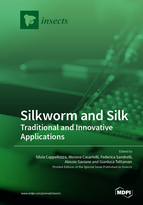Silkworm and Silk: Traditional and Innovative Applications
A special issue of Insects (ISSN 2075-4450).
Deadline for manuscript submissions: closed (30 June 2022) | Viewed by 71052
Special Issue Editors
Interests: sericulture; silkworm artificial diet; silkworm strain preservation and genetic improvement; silkworm pathology; silkworm rearing techniques and biotechnologies; silkworm for human and animal food/feeding
Interests: insect midgut physiology; insect biotechnology; silkworm as a model to study tissue remodeling during insect metamorphosis and mode of action of insecticidal molecules isolated from insect natural enemies; silkworm for human and animal food/feeding
Interests: insect biotechnology; insect immune response; silkworm antimicrobial peptides (AMPs); insect circadian rhythms
Interests: sericulture; silkworm genetics and biotechnologies; silkworm microbiology; pre and probiotics; silkworm microbiota; silkworm artificial diet; insects as feed/food; silkworm transgenesis
Interests: insect biotechnology; cell death and regeneration mechanisms in the silkworm; silkworm infection model; insect immune response; insect-mediated bioconversion of organic waste
Special Issue Information
Dear Colleagues,
The silkworm, Bombyx mori, has been intensively studied since time immemorial because of its economic relevance to silk production; on the other hand, with this insect being completely domesticated, the duration and any parameters of its development can be fully controlled by regulating environmental conditions. For this reason, this insect has been increasingly becoming a useful and suitable laboratory tool for research in genetics, physiology, animal nutrition, medicine, science of materials, chemistry, etc., just to mention some of the multiple application fields. Moreover, advances related to this insect have been accelerated by the sequencing of its genome. This impressive growth of knowledge related to the silkworm has encouraged the proliferation of sericultural advances described in scientific journals dealing with different topics. Therefore, there is a need to focus again on the unity of the sericultural sciences as a group of disciplines, with the silkworm as a binding element. The scope of this Special Issue is to give a comprehensive overview of the fields and applications for which the silkworm can be exploited, and even to reinforce the link between traditional sericulture and new technological horizons. In fact, silkworm rearing techniques and preservation, strain selection and maintenance, which represent the traditional activities, are the starting basis for any innovative application. In light of these considerations, the final purpose of this Special Issue is to establish a virtual dialogue between traditional sericulture and new trends in silkworm and silk valorization.
We would like to invite a) sericulturists dealing with traditional or new applications of sericulture and b) scientists involved in research on the silkworm as a biological model, or B. mori silk as a new material, to contribute to this issue with original research, reviews, or perspective articles focusing on how sericulture can contribute to the development of science, society, medicine, the environment, and economics. Any topics related to molecular, physiological, behavioral, environmental, social, historical, and other aspects of sericulture are welcome, as are reviews attempting to unify different research topics under comprehensive trends for future development.
Dr. Silvia Cappellozza
Prof. Dr. Morena Casartelli
Prof. Dr. Federica Sandrelli
Dr. Alessio Saviane
Prof. Dr. Gianluca Tettamanti
Guest Editors
Manuscript Submission Information
Manuscripts should be submitted online at www.mdpi.com by registering and logging in to this website. Once you are registered, click here to go to the submission form. Manuscripts can be submitted until the deadline. All submissions that pass pre-check are peer-reviewed. Accepted papers will be published continuously in the journal (as soon as accepted) and will be listed together on the special issue website. Research articles, review articles as well as short communications are invited. For planned papers, a title and short abstract (about 100 words) can be sent to the Editorial Office for announcement on this website.
Submitted manuscripts should not have been published previously, nor be under consideration for publication elsewhere (except conference proceedings papers). All manuscripts are thoroughly refereed through a single-blind peer-review process. A guide for authors and other relevant information for submission of manuscripts is available on the Instructions for Authors page. Insects is an international peer-reviewed open access monthly journal published by MDPI.
Please visit the Instructions for Authors page before submitting a manuscript. The Article Processing Charge (APC) for publication in this open access journal is 2600 CHF (Swiss Francs). Submitted papers should be well formatted and use good English. Authors may use MDPI's English editing service prior to publication or during author revisions.
Keywords
- genetics
- silkworm physiology
- silkworm pathology
- biotechnologies applied to sericulture
- silk utilisation and novel applications
- biological model
- sericultural practices
- environmental indicator
- silkworm as food and feed
- precision sericulture
- history of sericulture











